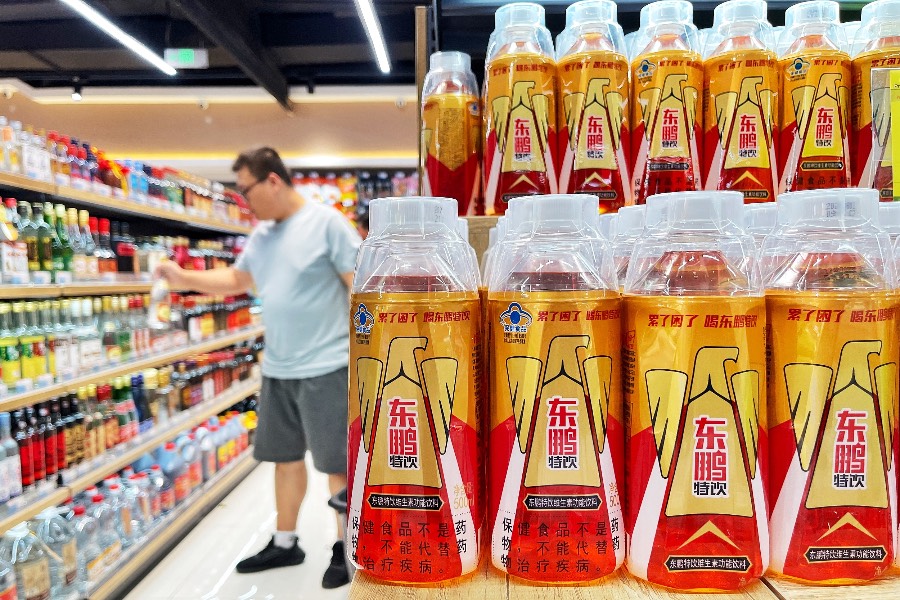Red Bull slayer Eastroc chases Hong Kong IPO to boost global charge

After finding a strong audience for its stock among domestic investors, the functional beverage maker aims to offer its stock to global buyers as well
Key Takeaways:
- Eastroc has filed for a Hong Kong IPO to complement its existing Shanghai listing, reporting its profit surged 63% last year to 3.33 billion yuan
- The company has been China’s top functional beverage brand by sales for four consecutive years
By Lau Chi Hang
Entrepreneur Zhong Shanshan’s rise to become China’s richest man on the back of his Nongfu Spring (9633.HK) bottled water empire awakened many to the huge potential of the country’s vast beverage market. Anyone doubting that need look no further than Coca Cola, Warren Buffett’s favorite stock, which has become an investor favorite on its wide stable of beverages, covering everything from soft drinks to healthier alternatives.
Another entrepreneur, Lin Muqin, may have sensed the market’s big potential when he entered a company formed more than three decades ago that would eventually become Eastroc Beverage (Group) Co. Ltd. (605499.SH), whose stock has more than quadrupled since listing in Shanghai in 2021. Now, the company is hoping to repeat that success by selling its shares to international investors in Hong Kong, touting its status as China’s leading functional beverage company. The deal could be quite large, reportedly raising $1 billion, according to media reports.
Soaring profits
According to its listing document filed earlier this month, Eastroc’s revenue grew from 8.5 billion yuan ($1.17 billion) in 2022 to 15.83 billion yuan in 2024, averaging 36.5% annual growth over that time. Its profit grew even faster, rising more than 40% annually from 1.44 billion yuan to 3.33 billion yuan over that period, with its gross margin ticking steadily upward from 41.6% to 44.1%.
The company has not only held the title of China’s largest functional beverage market for the last four years, but has consolidated its position by nearly doubling its market share from 15% in 2021 to 26.3% last year.
Functional beverages mainly cater to consumers looking for a pick-me-up to fight off fatigue and feel refreshed. According to third-party data in Eastroc’s listing document, the Chinese soft beverage market was worth 1.3 trillion yuan last year. Functional beverages were the fastest-growing segment within that, growing by an average of 8.3% annually from 2019 to 2024, well ahead of the 4.7% growth for the broader market during that time. The functional beverage market in China is expected to reach 281 billion yuan by 2029, as its average annual growth accelerates to 11% between 2024 and 2029.
Rebirth story
The current Eastroc traces its history back to 1987 with its founding as a state-owned company making herbal tea beverages. It was very much a second- or third-fiddle to Wong Lo Kat, the undisputed leader among herbal tea drinks in the 1990s. Lin Muqin was the company’s general sales manager when the state yanked its support in 2003. After stepping in, and following years of subsequent efforts, he managed to transform a company once on the brink of death into the functional beverage industry’s undisputed leader.
Timing played a key role in Lin’s success. With Wong Lo Kat reigning atop the herbal tea segment and the water business cornered by the trifecta of Wahaha, Nongfu Spring and Coke, Lin identified the functional beverage segment as a market where opportunities for newer companies still existed. The foreign Red Bull brand was growing fast at that time, but the overall market was still in a relatively early phase with room for growth and not overcrowded with competitors. So, Lin decided to throw his hat into the ring.
The company hasn’t been without controversy. At one point it was accused of plagiarizing Red Bull’s tag line that asked: “Worn out? Time for Red Bull!” with its very similar sounding “Worn out? Time for Eastroc!” But plagiarism aside, Eastroc’s success owes in no small part to its strategy of targeting the lower end of the market. While Red Bull cast its eye on more lucrative big-city markets, Lin insisted on expanding into smaller cities. His products were cheaper than Red Bull’s and, more importantly, the company avoided the biggest cities where Red Bull was king. In effect, it undermined its larger opponent by encircling it from the perimeter.
Lin was also quite adept at spotting new market trends. As a new generation of internet-savvy young Chinese grew up, he realized the importance of online marketing to attract those consumers who are some of the biggest buyers of functional beverages. So, the company bet big on entertainment channels favored by that group, including TV dramas, variety shows, web series and gaming.
Fading Red Bull
Still, Eastroc’s rise was also helped at least a little by sheer luck. For the company, that lucky turn came when Red Bull became caught up in an internal squabble. Red Bull rose to become the unequivocal leader in China’s functional beverage market after the brand’s owner, TCP Group, formed a partnership with Reignwood Group in 1995 to bring the drink to China. At its peak, Red Bull had more than 90% of the market, with no credible competition in sight.
But then a dispute broke out in 2016 between TCP and Reignwood over how long the latter had used the Red Bull trademark and whether that exceeded the original licensing period. A legal battle ensued, and the brand languished and stagnated as the two partners argued. By the time a court ruled against Reignwood in 2021, Eastroc had already overtaken Red Bull in China in terms of sales, and listed in Shanghai the same year.
By the end of last year, Eastroc had nearly 4 million end sales points across China, covering most of the country’s smaller cities. Having conquered China, Lin is now looking beyond his home market for new growth overseas. The Hong Kong listing is part of that plan, not only raising cash for such an expansion but also helping the company to quickly boost its name.
Eastroc said it planned to use proceeds from the IPO to improve its productive capacity, upgrade its supply chain, further build its brand and boost its consumer engagement. Meanwhile, it said it will also explore more overseas business opportunities, including potential acquisitions.
Eastroc’s Shanghai stock currently trades at a price-to-earnings (P/E) ratio of 40. Since Hong Kong currently has no listed functional beverage companies, Nongfu Spring and China Resources Beverage (2460.HK) may serve as good references for calculating how the company might be valued after a Hong Kong listing. That pair trade at P/E ratios of 30 and 20 times, respectively, averaging 25. A similar valuation for Eastroc would value the company at about HK$83 billion ($10.7 billion).
To subscribe to Bamboo Works weekly free newsletter, click here





